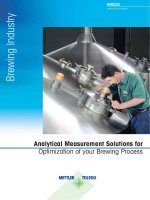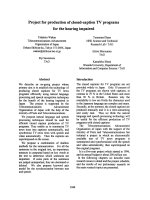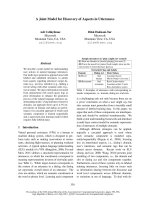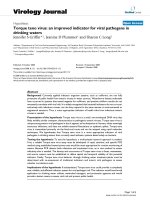Improved oxides for production of leadracid battery plates pot
Bạn đang xem bản rút gọn của tài liệu. Xem và tải ngay bản đầy đủ của tài liệu tại đây (160.72 KB, 4 trang )
Ž.
Journal of Power Sources 73 1998 56–59
Improved oxides for production of leadracid battery plates
D.P. Boden
)
Hammond Group, 2308 165th Street, Hammond, IN 46320, USA
Received 5 August 1997; accepted 10 October 1997
Abstract
Ž.
For many years, the plates of leadracid batteries have been produced from leady oxide, a mixture of finely divided lead ‘free-lead’
and lead monoxide. Although this material is generally satisfactory, it suffers from the disadvantages that it is variable in composition and
requires complicated and lengthy processing after pasting to remove the residual free-lead. Plates made from leady oxide also require
cycling before they achieve their full performance, and this can result in either depressed initial capacity or additional processing cost.
Ž.
There is a growing trend towards the use of pure lead monoxide
b
-PbO for the production of positive plates. This material is
particularly valuable in valve-regulated batteries where cell-to-cell uniformity is essential for proper control of battery performance. It
Ž.
also reduces processing cost since it does not require time-consuming curing to remove free-lead. Red lead Pb O is also being more
34
widely used in industrial batteries since it reduces formation time, and improves initial and high-rate performance. The methods of
production of leady oxide,
b
-PbO and red lead are briefly reviewed and the characteristics of battery-grade materials are described.
Particular emphasis is placed on optimum particle-size distribution, and how this can affect the battery performance. The benefits in
processing and performance are described together with information on how pure litharge and red lead are used in battery plates. q 1998
Elsevier Science S.A. All rights reserved.
Keywords: Leady oxide; Lead monoxide; Leadracid battery; Red lead; Barton pot; Ball mill
1. Introduction
A discernable trend is taking place in the type of oxide
used to produce industrial batteries. Leady oxide is being
replaced in some types of battery, most noticeably valve-
Ž.
regulated types, by pure litharge,
a
-PbO . Additionally,
producers of industrial batteries are using increasing quan-
tities of red lead in their positive plates to take advantage
of the performance-enhancing properties of this oxide.
In this paper, the characteristics of the various types of
lead oxides used in batteries will be reviewed, their manu-
facturing methods described, and their advantages and
disadvantages outlined.
2. Characteristics of lead oxides
The structures of the two polymorphic forms of lead
monoxide are shown in Fig. 1 and the structure of red lead
wx
is shown in Fig. 2 1 . The alpha or red form of the
Ž.
monoxide the mineral litharge is tetragonal, and the
)
Corresponding author.
Ž.
crystals are tabular on the 001 plane. The beta or yellow
Ž.
form is orthorhombic the mineral massicot and the crys-
Ž.
tals are tabular on the 100 plane. Some physical data for
a
-PbO and
b
-PbO are shown in Table 1, and for Pb O in
34
wx
Table 2 2 .
The lead monoxide manufactured by the ball-mill pro-
Ž.
cess is almost pure tetragonal
a
-PbO while that produced
by the Barton-pot process can contain up to 10 wt.% of the
Ž.
orthorhombic form
b
-PbO depending on the temperature
during the process.
The characteristics of leady oxide that are most impor-
tant to battery manufacturers, with typical values for auto-
motive and industrial applications are shown in Table 3.
These data are for Barton-pot oxides which are the most
widely used in the USA Oxide produced in a ball-mill has
Ž
y1
.
a higher acid absorption value ; 240 mg g and a
wx
greater surface area than Barton oxide. In a survey 3 of a
considerable number of Barton-pot and ball-mill oxide
samples, Barton-pot material had BET surface areas rang-
ing from 0.55 to 0.84 m
2
g
y1
while the corresponding
range for ball-mill oxide was 1.16 to 1.79 m
2
g
y1
. Interest-
ingly, the values for total pore volume and median pore
diameter did not differ appreciably. The total pore volume
0378-7753r98r$19.00 q 1998 Elsevier Science S.A. All rights reserved.
Ž.
PII S0378-7753 98 00021-4
()
D.P. BodenrJournal of Power Sources 73 1998 56–59 57
Ž. Ž
Fig. 1. Crystal structures of
a
-PbO Tetragonal and
b
-PbO Ortho-
.
rhombic .
for the Barton-pot samples had a range of 0.192 to 0.264
cm
3
g
y1
, and for the ball-mill samples, 0.20 to 0.298 cm
3
g
y1
For the median pore diameter, the Barton samples had
Fig. 2. Crystal structure of Pb O .
34
Table 1
Physical data of
a
-PbO and
b
-PbO
a
-PbO
b
-PbO
Structure Tetragonal Orthorhombic
Mohs hardness 2 2
y3
Ž.
Density g cm 9.14 9.56
n
Refractive index w s 2.665 xs2.51
Li Li
e
s2.535 ys2.61
Li
zs2.71
˚
Ž.
Lattice constants A a s3.96 a s5.476
oo
c s5.01 b s5.486
oo
PbO–Os 2.30 c s4.743
o
Pb–Os 2.221
Dielectric constant 32 35
y1 y14 y14
Ž.
Electrical conductivity V cm ;10 ;10
a range of 1.50 to 2.64
m
m, and for the ball-mill samples,
1.67 to 2.67
m
m. Since there is little perceived difference
between batteries made from Barton-pot and ball-mill ox-
ide, this may suggest that pore volume and diameter are
more important characteristics than surface area and acid
absorption.
2.1. Pure lead monoxide
Calcined orthorhombic
b
-PbO is becoming more widely
used as a starting material for battery plates. Typical
characteristics of battery-grade
b
-PbO are shown in Table
4.
This oxide differs from leady oxide in a number of
important respects. Most important is the absence of free-
lead. The particle size is larger and the acid absorption is
lower than generally required for automotive batteries, but
approximately equivalent to leady oxide used in industrial
batteries. It is noteworthy that the acid absorption of pure
b
-PbO is higher than would be expected from its particle-
size distribution. This is probably due to its greater reactiv-
Ž
ity J.L. Nordyke, Hammond Lead Products, private com-
.
munication .
The absence of free-lead significantly improves the
reproducibility of the paste mixing and curing processes.
With a leady oxide, some of the free-lead is oxidized
during paste mixing and further oxidation takes place
Table 2
Ž.
Physical data for red lead Pb O
34
Property Value
Structure Tetragonal
Mohs hardness 2–3
y3
Ž.
Density g cm 4.6
n
Refractive index s2.42
Li
˚
Ž.
Lattice constants A a s8.788
o
c s6.551
o
Dielectric constant 20
y1 y12
Ž.
Electrical conductivity V cm ;10
()
D.P. BodenrJournal of Power Sources 73 1998 56–5958
Table 3
Ž.
Characteristics of leady oxide Barton-pot process for different battery
applications
Characteristic Automotive batteries Industrial batteries
Ž.
Free-Lead wt.% 18–24 22–28
y3
Ž.
Apparent density g in. 18–24 23–29
y1
Ž.
Acid absorption mg g 170–210 130–155
Particle size:
Ž.
Median
m
m 2.2 2.8
% below 1 10–15 5–10
Alpha:beta ratio 96:4 96:4
during pasting and curing. The amount of free lead oxi-
dized at each step in the process is often variable and
results in changes in the paste characteristics, and in the
composition of the finished plate. This can result in vari-
ability in cells made from these plates. The latter can be a
significant problem in valve-regulated batteries where cell-
to-cell voltage repeatability is very important for proper
long-term operation under oxygen-recombination condi-
tions.
Another advantage of
b
-PbO is the elimination of the
lead oxidation step in the curing process. This significantly
reduces curing time and allows the process conditions to
be designed to produce the optimum ratio of tribasic and
tetrabasic lead sulfate in the plates.
2.2. Red lead
Red lead is beneficial in improving the electrochemical
performance of cells and batteries. The lead is in a higher
Ž.
oxidation state than lead monoxide ratio of Pb:Os 1.33
and its electrical conductivity is also greater. Batteries
made with red lead in the positive paste can be formed
quicker, and their initial capacity is higher than those made
from leady oxide pastes.
The red lead is normally used in either of two ways. A
Ž.
high percentage red lead ) 80 wt.% Pb O can be
34
blended into the paste mixture to produce the desired
amount in the finished plate, or the paste can be made
Ž.
from a lower percentage red lead ; 25 wt.% Pb O
34
which is substituted for leady oxide. In either way, paste
mixing and plate processing are very similar to those with
Table 4
Typical characteristics of battery-grade, orthorhombic,
b
-PbO
Characteristic Value
Ž.
Free-lead wt.% 0.1
y3
Ž.
Apparent density g in. 26–32
y1
Ž.
Acid absorption mg g 125–150
Particle size:
Ž.
Median
m
m 4.5
%- 2
m
m20
%-1
m
m5
wt.% Beta-PbO 90
Table 5
Typical specifications for battery-grade red lead
25 wt.% red lead 80 wt.% red lead
wt.% Pb O 25 80
34
wt.% PbO 75 20
wt.% Pb 2.5 max 0.5 max
y3
Ž.
Apparent density g in. 19–25 16–19
y1
Ž.
Acid absorption mg g 170–200 200–230
Ž.
Median particle size
m
m 3.0 2.0
conventional leady oxide. Typical specifications for bat-
tery-grade red lead are shown in Table 5. The particle size
decreases and the acid absorption increases as the percent-
age of Pb O in the red lead is increased. Consequently, if
34
a paste mix is being produced that contains 25 wt.%
Pb O , a better result is generally obtained when this is
34
added as the high percentage material because of its
greater reactivity.
3. Production methods
Most of the lead oxide used by the battery industry in
the USA is produced by the Barton-pot process because of
its flexibility and low cost. Barton-pot oxide is also used as
the raw material feedstock for the production of pure PbO
and red lead. A schematic flow chart of the process used to
Fig. 3. Schematic diagram of flow process for production of leady oxide,
lead monoxide, and red lead.
()
D.P. BodenrJournal of Power Sources 73 1998 56–59 59
produce leady oxide, pure PbO and red lead is shown in
Fig. 3. Lead, of the required purity, is melted in a kettle
and then fed into a reaction vessel fitted with a rotating
paddle. Air is drawn through this reactor and leady oxide
is drawn off by the air stream and classified by conven-
tional methods. By careful control of temperature, air flow
and paddle speed, oxide of varying characteristics can be
produced. Generally, the temperature will influence the
amount of free-lead in the product, and the ratio of alpha-
to beta-PbO. The velocity of the air flow will influence the
free lead and the particle size of the material.
Pure
b
-PbO and red lead are produced in calcining
furnaces in which the raw material is agitated while being
heated at the optimum temperature for oxidation to the
required product. In the case of pure
b
-PbO, the tempera-
ture is held at 6008C while for the production of red lead a
range of 450 to 5008C is used. In the case of red lead, the
furnace is discharged when the desired amount of Pb O
34
has been reached. Oxide with 25 wt.% Pb O can be made
34
in 5–6 h, while production of an oxide with 80 wt.%
Pb O may require 16–18 h of calcining.
34
3.1. Particle-size control
The particle-size distribution is the most important
physical property of battery oxide. It strongly influences
both the performance characteristics and the life of the
battery. Such measurements as apparent density and acid
absorption, which are widely used by the battery industry,
are reasonably good indicators of the particle-size distribu-
tion. The lower the particle size of the oxide, the higher
will be the acid absorption and the lower will be the
apparent density.
Although Barton-pot systems are capable of some de-
gree of particle-size control by adjustment of process
parameters, a much greater degree of control and of flexi-
bility is achieved when the system incorporates a hammer
mill. In a hammer mill, a number of hammers are fitted to
a rotating shaft with a variable speed drive. A stream of air
is drawn through the mill which can be adjusted by a
damper setting. Consequently, the dwell time of the mate-
rial in the mill can be varied. Depending on the air
velocity, the number of hammers, and the speed of rota-
tion, the material being fed into the mill can be ground to
wide range of particle-size distributions. Process settings
have been developed which allow a high degree of control
over the median particle size and the amount of fine
particles in the product.
A typical example of the particle-size distribution of
leady oxide before and after milling is shown in Fig. 4. In
this series of experiments, the mill was equipped with four
hammers and the speed of rotation was kept constant.
Fig. 4. Effect of mill on the particle-size distribution of leady oxide.
Changes were made to the air velocity by adjustment to
the damper. By reducing the air velocity it was possible to
make significant changes to the particle-size distribution.
The median particle size was reduced from 5.3 to 2.1
m
m
and the amount below 1
m
m was increased from 1 to 24%.
Further comminution of the material is possible by increas-
ing the number of hammers andror the speed of rotation.
4. Conclusions
Ž.
Pure lead monoxide
b
-PbO and red lead, as active
materials in batteries, can yield a number of benefits
compared to with leady oxide. Pure
b
-PbO gives improved
reproducibility in paste mixing and simplifies the curing
process. The absence of free-lead results in reduced plate-
to-plate variation which, in turn, leads to more uniform
float voltages in standby and valve-regulated batteries. Red
lead can yield such benefits as reduced formation time,
improved initial capacity, and superior high-rate perfor-
mance.
Barton-pot systems coupled with a hammer mill are
extremely flexible and are capable of producing oxides
with a wide range of particle-size distributions suitable for
automotive and industrial applications.
References
wx
1 H.E. Brown, Lead oxide, Properties and applications, international
lead zinc research organization, 1985.
wx
2 M. Neuberger, Lead oxide, Air force materials laboratory, Research
Ž.
and technology division, Contract AF 33 615 -2460, 1967.
wx
3 G.L. Corino, R.J. Hill, A.M. Jessel, D.A.J. Rand, J.A. Wurderlich, J.
Ž.
Power Sources 16 1985 141–168.









